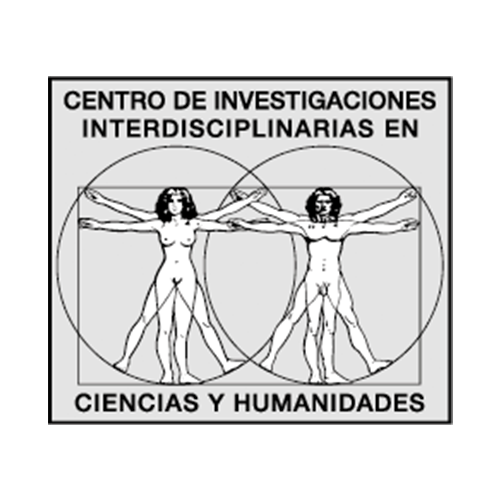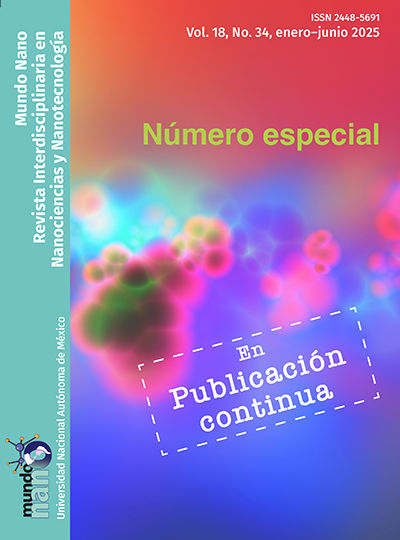Bismuth subsalicylate nanoparticles by laser ablation: effect against bacteria associated with nosocomial infections
Main Article Content
Abstract
Objective: to evaluate the antibacterial effect of bismuth subsalicylate nanoparticles (NPs-SSBi) against four bacteria, frequently associated with nosocomial infections. Methods: the NPs-SSBi were obtained in colloidal suspension by laser ablation of solids in liquids (ALSL). The size, composition, and stability of the NPs in suspension were analyzed by transmission electron microscopy and ultraviolet-visible spectroscopy. The planktonic growth and biofilm formation of two Gram-positive bacteria, S. aureus and S. epidermidis, and two Gram-negative bacteria, E. coli and P. aeruginosa, after exposure to different concentrations of NPs-SSBi (1.25 to 90 μg/mL), were evaluated by turbidity and XTT assays, respectively. Results: quasi-spherical crystalline NPs-SSBi were obtained, with a size of 4.5 ± 0.14 nm, which remain stable in colloidal suspension for at least 21 days. The NPs-SSBi inhibited the growth of all four bacteria, planktonic growth was reduced ≈80-92% at concentrations above 40 μL/mL, and biofilm formation ≈73-89% at concentrations of 80 and 90 μL/mL. Conclusions: the NPs-SSBi obtained by ALSL inhibited the growth of four important nosocomial bacteria, so they could be used for the control of health care-associated infections.
Downloads
Article Details

Mundo Nano. Revista Interdisciplinaria en Nanociencias y Nanotecnología por Universidad Nacional Autónoma de México se distribuye bajo una Licencia Creative Commons Atribución-NoComercial 4.0 Internacional.
Basada en una obra en http://www.mundonano.unam.mx.
References
Alharbi, S. A., Mashat, B. H., Al-Harbi, N. A., Wainwright, M., Aloufi, A. S. y Alnaimat, S. (2012). Bismuth-inhibitory effects on bacteria and stimulation of fungal growth in vitro. Saudi Journal of Biological Sciences, 19(2): 147-150. https://doi.org/10.1016/j.sjbs.2012.01.006. DOI: https://doi.org/10.1016/j.sjbs.2012.01.006
Allegranzi, B., Nejad, S. B., Combescure, C., Graafmans, W., Attar, H., Donaldson, L. y Pittet, D. (2011). Burden of endemic health-care-associated infection in developing countries: systematic review and meta-analysis. The Lancet, 377(9761): 228-241. https://doi.org/10.1016/S0140-6736(10)61458-4. DOI: https://doi.org/10.1016/S0140-6736(10)61458-4
Arena, J. (1974). Poisoning. Toxicology, symptoms, treatments. (American lecture series, 1019: American lectures in living chemistry). EUA: Universidad de Míchigan.
Badireddy, A. R., Hernández-Delgadillo, R., Sánchez-Nájera, R. I., Chellam, S. y Cabral-Romero, C. (2014). Synthesis and characterization of lipophilic bismuth dimercaptopropanol nanoparticles and their effects on oral microorganisms growth and biofilm formation. Journal of Nanoparticle Research, 16(6): 2456. https://doi.org/10.1007/s11051-014-2456-5. DOI: https://doi.org/10.1007/s11051-014-2456-5
Bagchi, D., McGinn, T. R., Ye, X., Balmoori, J., Bagchi, M., Stohs, S. J., Kuszynski, C. A., Carryl, O. R. y Mitra, S. (1999). Mechanism of gastroprotection by bismuth subsalicylate against chemically induced oxidative stress in cultured human gastric mucosal cells. Dig Dis Sci, 44(12): 2419-2428. https://doi.org/10.1023/a:1026618501729. DOI: https://doi.org/10.1016/S0016-5085(98)80251-5
Braissant, O., Astasov-Frauenhoffer, M., Waltimo, T. y Bonkat, G. (2020). A review of methods to determine viability, vitality, and metabolic rates in microbiology. Frontiers in Microbiology, 11: 547458. DOI: https://doi.org/10.3389/fmicb.2020.547458
Budavari, S. (ed.). (1996). The Merck index: an encyclopedia of chemicals, drugs, and biologicals, 12a ed. New Jersey, EUA: Merck Research Laboratories.
Cornick, N. A., Silva, M. y Gorbach, S. L. (1990). In vitro antibacterial activity of bismuth subsalicylate. Rev Infect Dis, 12(Supl. 1): S9-10. https://doi.org/10.1093/clinids/12.supplement_1.s9. DOI: https://doi.org/10.1093/clinids/12.Supplement_1.S9
Costerton, J. W., Stewart, P. S. y Greenberg, E. P. (1999). Bacterial biofilms: a common cause of persistent infections. Science, 284(5418): 1318-1322. https://doi.org/10.1126/science.284.5418.1318. DOI: https://doi.org/10.1126/science.284.5418.1318
Dalgaard, P., Ross, T., Kamperman, L., Neumeyer, K. y McMeekin, T. A. (1994). Estimation of bacterial growth rates from turbidimetric and viable count data. International Journal of Food Microbiology, 23(3): 391-404. https://doi.org/10.1016/0168-1605(94)90165-1. DOI: https://doi.org/10.1016/0168-1605(94)90165-1
Dodge, A. G. y Wackett, L. P. (2005). Metabolism of bismuth subsalicylate and intracellular accumulation of bismuth by Fusarium sp. strain BI. Appl Environ Microbiol, 71(2): 876-882. https://doi.org/10.1128/AEM.71.2.876-882.2005. DOI: https://doi.org/10.1128/AEM.71.2.876-882.2005
Domenico, P., Landolphi, D. R. y Cunha, B. A. (1991). Reduction of capsular polysaccharide and potentiation of aminoglycoside inhibition in Gram-negative bacteria by bismuth subsalicylate. J Antimicrob Chemother, 28(6): 801-810. https://doi.org/10.1093/jac/28.6.801. DOI: https://doi.org/10.1093/jac/28.6.801
Flemming, H.-C. y Wingender, J. (2010). The biofilm matrix. Nature Reviews Microbiology, 8(9): 623-633. https://doi.org/10.1038/nrmicro2415. DOI: https://doi.org/10.1038/nrmicro2415
Flores-Castañeda, M., González, E. C., Ruiz-Aguilar, I., Camps, E., Cruces, M. P., Pimentel, E. y Camacho-López, M. (2019). Preparation and characterization of organic nanoparticles by laser ablation in liquids technique and their biological activity. Materials Research Express, 6(10): 105091. https://doi.org/10.1088/2053-1591/ab3cf1. DOI: https://doi.org/10.1088/2053-1591/ab3cf1
Gómez Muñoz, C., Valdés Castro, R., Rodríguez Sánchez, Y. y Figueroa Moreno, R. (2023). Disertación del Boletín Infecciones Asociadas con la Atención de la Salud, agosto 2022. Medicina Interna de México, 39(5). https://doi.org/10.24245/mim.v39i5.8403.
Gosselin, R. H., H. C., Smith, R. P., Gleason, M. N. (1976 ). Clinical toxicology of commercial products. Acute poisoning. Baltimore, M.D.: Williams & Wilkins.
Habashi, F. (2013). Bismuth, physical and chemical properties. En R. H. Kretsinger, V. N. Uversky y E. A. Permyakov (eds.), Encyclopedia of metalloproteins. Nueva York: Springer, 283-284. https://doi.org/10.1007/978-1-4614-1533-6_413. DOI: https://doi.org/10.1007/978-1-4614-1533-6_413
Hajipour, M. J., Fromm, K. M., Akbar Ashkarran, A., Jiménez de Aberasturi, D., Larramendi, I. R. d, Rojo, T., Serpooshan, V., Parak, W. J. y Mahmoudi, M. (2012). Antibacterial properties of nanoparticles. Trends in Biotechnology, 30(10): 499-511. https://doi.org/10.1016/j.tibtech.2012.06.004. DOI: https://doi.org/10.1016/j.tibtech.2012.06.004
Ibrahimkutty, S., Wagener, P., Rolo, T. D. S., Karpov, D., Menzel, A., Baumbach, T., Barcikowski, S. y Plech, A. (2015). A hierarchical view on material formation during pulsed-laser synthesis of nanoparticles in liquid. Scientific Reports, 5(1): 16313. https://doi.org/10.1038/srep16313. DOI: https://doi.org/10.1038/srep16313
Kappstein, I. y Engels, I. (1987). Antibacterial activity of sucralfate and bismuth subsalicylate in simulated gastric fluid. Eur J Clin Microbiol, 6(2): 216-217. http://www.ncbi.nlm.nih.gov/pubmed/3595590. DOI: https://doi.org/10.1007/BF02018225
Koulinska, I., Riester, K., Chalkias, S. y Edwards, M. R. (2018). Effect of bismuth subsalicylate on gastrointestinal tolerability in healthy volunteers receiving oral delayed-release dimethyl fumarate: PREVENT, a randomized, multicenter, double-blind, placebo-controlled study. Clin Ther, 40(12): 2021-2030 e2021. https://doi.org/10.1016/j.clinthera.2018.10.013. DOI: https://doi.org/10.1016/j.clinthera.2018.10.013
Lambert, J. R. y Midolo, P. (1997). The actions of bismuth in the treatment of Helicobacter pylori infection. Aliment Pharmacol Ther, abril 11(Supl. 1): 27-33. https://doi.org/10.1046/j.1365-2036.11.s1.13.x. DOI: https://doi.org/10.1046/j.1365-2036.11.s1.13.x
Lewis, R. J. (2007). Hawley’s condensed chemical dictionary, 12a ed., vol. 129. American Chemical Society. https://doi.org/10.1021/ja0769144.
Li, R. C., Nix, D. E. y Schentag, J. J. (1993). New turbidimetric assay for quantitation of viable bacterial densities. Antimicrobial Agents and Chemotherapy, 37(2): 371-374. https://doi.org/doi:10.1128/aac.37.2.371. DOI: https://doi.org/10.1128/AAC.37.2.371
Mafune, F., Kohno, J., Takeda, Y., Kondow, T. y Sawabe, H. (2000). Formation and size control of silver nanoparticles by laser ablation in aqueous solution. J. Phys. Chem. B, 104(39): 9111-9117. https://doi.org/10.1021/jp001336y. DOI: https://doi.org/10.1021/jp001336y
Magill, S. S., Edwards, J. R., Bamberg, W., Beldavs, Z. G., Dumyati, G., Kainer, M. A., ... y Fridkin, S. K. (2014). Multistate point-prevalence survey of health care–associated infections. New England Journal of Medicine, 370(13): 1198-1208. https://doi.org/10.1056/NEJMoa1306801. DOI: https://doi.org/10.1056/NEJMoa1306801
Mira, P., Yeh, P. y Hall, B. G. (2022). Estimating microbial population data from optical density. PLOS ONE, 17(10): e0276040. https://doi.org/10.1371/journal.pone.0276040. DOI: https://doi.org/10.1371/journal.pone.0276040
OMS. (2022). OMS publica el primer informe mundial sobre prevención y control de infecciones (PCI). https://www.who.int/es/news/item/06-05-2022-who-launches-first-ever-global-report-on-infection-prevention-and-control.
Pitz, A. M., Park, G. W., Lee, D., Boissy, Y. L. y Vinje, J. (2015). Antimicrobial activity of bismuth subsalicylate on Clostridium difficile, Escherichia coli O157:H7, norovirus, and other common enteric pathogens. Gut Microbes, 6(2): 93-100. https://doi.org/10.1080/19490976.2015.1008336. DOI: https://doi.org/10.1080/19490976.2015.1008336
Purvis, J. E. (1926). CV.—The absorption spectra of various derivatives of salicylic acid. Journal of the Chemical Society (Resumed), 129(0): 775-778. https://doi.org/10.1039/JR9262900775. DOI: https://doi.org/10.1039/JR9262900775
Radzig, M. A., Nadtochenko, V. A., Koksharova, O. A., Kiwi, J., Lipasova, V. A. y Khmel, I. A. (2013). Antibacterial effects of silver nanoparticles on Gram-negative bacteria: Influence on the growth and biofilms formation, mechanisms of action. Colloids and Surfaces B: Biointerfaces, 102: 300-306. https://doi.org/10.1016/j.colsurfb.2012.07.039. DOI: https://doi.org/10.1016/j.colsurfb.2012.07.039
Reyes-Carmona, L., Camps, E., Campos-González, E., Mercado-Celis, G., Cervantes-Garduño, A., Pérez-Ibarra, E. A., Álvarez-Chimal, R., Rodil, S. E. y Almaguer-Flores, A. (2023). Antimicrobial evaluation of bismuth subsalicylate nanoparticles synthesized by laser ablation against clinical oral microorganisms. Optics & Laser Technology, 158: 108930. https://doi.org/10.1016/j.optlastec.2022.108930. DOI: https://doi.org/10.1016/j.optlastec.2022.108930
Roehm, N. W., Rodgers, G. H., Hatfield, S. M. y Glasebrook, A. L. (1991). An improved colorimetric assay for cell proliferation and viability utilizing the tetrazolium salt XTT. J Immunol Methods, 142(2): 257-265. https://doi.org/10.1016/0022-1759(91)90114-u. DOI: https://doi.org/10.1016/0022-1759(91)90114-U
Semaltianos, N. G., Hendry, E., Chang, H., Wears, M. L., Monteil, G., Assoul, M., Malkhasyan, V., Blondeau-Patissier, V., Gauthier-Manuel, B. y Moutarlier, V. (2016). ns or fs pulsed laser ablation of a bulk InSb target in liquids for nanoparticles synthesis. J Colloid Interfaces, (469): 57-62. https://doi.org/10.1016/j.jcis.2016.01.069. DOI: https://doi.org/10.1016/j.jcis.2016.01.069
Sox, T. E. y Olson, C. A. (1989). Binding and killing of bacteria by bismuth subsalicylate. Antimicrob Agents Chemother, 33(12): 2075-2082. https://doi.org/10.1128/aac.33.12.2075. DOI: https://doi.org/10.1128/AAC.33.12.2075
USGS. (2021). Mineral commodity summaries 2021. Report. Mineral Commodity Summaries, Issue. U. S. G. Survey. https://pubs.usgs.gov/publication/mcs2021.
Vega-Jiménez, A., Berea-Montes, E. y Almaguer-Flores, A. (2012). Susceptibility of E. coli, P. aeruginosa, S. aureus and S. epidermidis to different bismuth compounds. MRS Proceedings, 1487. DOI: https://doi.org/10.1557/opl.2012.1525
Vega-Jiménez, A. L., Almaguer-Flores, A., Flores-Castañeda, M., Camps, E., Uribe-Ramírez, M., Aztatzi-Aguilar, O. G. y De Vizcaya-Ruiz, A. (2017). Bismuth subsali - cylate nanoparticles with anaerobic antibacterial activity for dental applications. Nanotechnology, 28(43): 435101. https://doi.org/10.1088/1361-6528/aa8838. DOI: https://doi.org/10.1088/1361-6528/aa8838
Yakoob, J., Abbas, Z., Usman, M. W., Awan, S., Naz, S., Jafri, F., Hamid, S. y Jafri, W. (2014). Comparison of antimicrobial activity of zinc chloride and bismuth subsalicylate against clinical isolates of Helicobacter pylori. Microb Drug Resist, 20(4): 305-309. https://doi.org/10.1089/mdr.2013.0086. DOI: https://doi.org/10.1089/mdr.2013.0086
Yang, G. W. (ed.). (2012). Laser ablation in liquids. Principles and applications in the preparation of nanomaterials. Nueva York: Jenny Stanford Publishing, 1192 pp. https://doi.org/Book_Doi 10.1201/B11623. DOI: https://doi.org/10.1201/b11623





